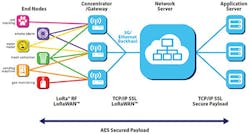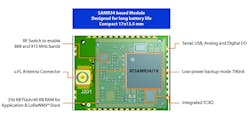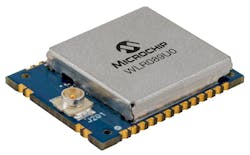The 4 Building Blocks for LoRa Networks
What you’ll learn:
- The four main elements of LoRa network architecture.
- Some of the common challenges faced by designers while developing LoRa end nodes and how to work around them.
- How regulatory certified LoRa modules helps overcome these challenges and reduces time to market.
Long-range (LoRa) technology is extending the reach of the Internet of Things (IoT) by combining long-range wireless connectivity with low-power performance. From smart cities to smart agriculture to supply-chain tracking, LoRa is an ideal choice to create flexible IoT networks that can operate in both urban and rural environments. But how easy is it really to develop a new LoRa solution or migrate to one?
Understanding a new wireless technology and choosing the right solution for your application can be exhausting. Wireless radio-frequency (RF) design usually requires in-depth RF expertise and adds significant development time for designers.
LoRaWAN Network Architecture
LoRa is a wireless modulation technique or physical layer that allows low-power end-devices to communicate over long range. LoRaWAN—a wireless networking protocol that acts as a media-access-control (MAC) layer—is implemented on top of the LoRa physical layer. The LoRaWAN specification details the communication protocol and network architecture and is meant to provide secure communication of end-devices and interoperability within the network.
The LoRa network has four elements (Fig. 1):
- End-nodes are elements of the LoRa ecosystem that gather sensor data and transmit/receive the data. They’re generally remotely connected and are battery-powered.
- The gateway is a transparent bridge between the end-nodes and network server. Typically, end-nodes use LoRaWAN to connect to the gateway, while the gateway uses high-bandwidth networks such as Wi-Fi, Ethernet, or cellular to connect to the networks.
- A network server connects to multiple gateways. It gathers data from the gateways and filters out duplicate messages, decides which gateway should respond to end-node messages, and adapts data rates to extend battery life of end-nodes.
- The application server collects data from end-nodes and controls the actions of the end-node devices.
Let’s take a closer look at LoRa end-nodes and the challenges in designing them.
Common Challenges in Designing LoRa End-Nodes
End-nodes are simple objects, such as sensors and actuators. Typically, they comprise the “things” within the Internet of Things (IoT). In the LoRaWAN ecosystem, an end-node communicates to the network server through one or many gateways.
LoRa end-nodes are typically low-cost battery-powered applications that need to be power-efficient. Depending on the development time, target costs, power consumption, and RF expertise available, several options are available to build LoRa end-nodes. Before researching those options, let’s look at some of the most common challenges that designers face when designing end-nodes. They include:
RF Design
As with any wireless design, significant RF design expertise is needed when designing LoRa end-nodes. When using LoRa systems-on-chip/systems-in-package (SoCs/SiPs), the end-node device developer is responsible for the entire RF design, including schematics, bill of materials (BOM), PCB layout, antenna tuning, and other RF hardware.
Even with the best documentation and application design guides, RF design isn’t always easy. It not only requires in-depth RF expertise, but also adds up significant development time for designers. Furthermore, debugging RF designs most often requires special equipment, adding further to the development costs.
To overcome the RF design challenges, some suppliers offer SoCs/SiPs that are supported by excellent documentation, regulatory certified reference designs, and detailed chip-down design packages. However, for the shortest development time and reduced risk, an RF optimized, tested, and certified LoRa module is almost always the best choice. These modules can provide a complete solution as a single component reducing design risk and development times.
Regulatory Compliance and Certifications
LoRa/sub-GHz radios typically operate in the ISM license-free band. The frequencies vary depending on the region, making it challenging for hardware and software designers. Diligent care must be taken to design a fully compliant solution while keeping the BOM costs minimal. Also, RF regulatory requirements are constantly changing. Thus, keeping up with the regulatory changes, re-testing the devices, and re-certifying for compliance can cost several thousands of dollars—as well as engineering time—for end-node developer companies, money and time that could otherwise be spent on new projects.
Using a certified LoRa module solves this issue easily; the module manufacturer takes care of keeping up with the regulatory requirements and re-certifying modules to the latest specifications. All of these costs and time spent on regulatory compliance can be completely avoided by choosing a regulatory certified LoRa module.
Multi-Region Operation
LoRa devices support several frequencies, depending on the region. Often end-node manufacturers release their end-products in one major region first. Once the demand ramps up, companies investigate expanding the same design in other regions. Having a single SKU that supports multiple regions allows for seamless migration and expansion of the end-product into different countries and regions. A regulatory certified LoRa module that works for multiple frequency bands is ideal for this type of product expansion.
Robust Software
Generally, LoRa modules integrate the whole LoRaWAN stack inside the module. The end-node developer only needs to implement the initialization and communication to the module. With LoRa SoCs/SiPs and with standalone LoRa modules, the stack must either be provided by the manufacturer, or the developer must develop its own stack if no stack is provided.
To minimize software development, it’s recommended to choose LoRa modules/ICs that are supported by the manufacturer’s LoRaWAN stack. Proven LoRaWAN stacks from manufacturers ensure interoperability of end-nodes with major LoRaWAN networks and gateways, enabling end-nodes to work across different networks with reduced risk.
Migration Path from Modules to SoCs
Many companies start their prototypes and initial production runs with certified modules to reduce risk and get their products faster into market. Once their product starts to ramp up, companies may decide to move to LoRa SoCs/ICs for increased flexibility or lower BOM costs. The migration isn’t always easy, so it’s very important to consider standalone modules that allow for simple software migration between the modules and ICs. Also, it’s essential to choose suppliers that sell both modules and SoCs; therefore, the development platform, software migration, and support structure remain the same.
Regulatory Certified LoRa Modules Simplify LoRa End-Node Designs
LoRa modules consist of all required radio components along with LoRaWAN stack and RF circuitry, thus helping accelerate development of LoRaWAN end-devices. Since the RF development and the certification are implemented by the module manufacturer, any changes in certification specifications or component replacements are completely handled by the manufacturer, saving tons of development time as well as re-certification costs for end-device manufacturers.
Standalone LoRa modules with highly integrated LoRa ICs provide enough memory to run the application code along with the LoRaWAN stack. This eliminates the need for an external microcontroller, saving board space and system costs. Figures 2 and 3 show a simple example of such a standalone module.
The WLR089U0 module based on the SAM R34/35 family of ICs from Microchip Technology is a compact module with 256 kB of flash and 40 kB of RAM, making it well-suited for space-constrained applications. Also, the module includes an integrated RF switch, enabling multi-band operation and allowing the same module to be used across multiple geographies, facilitating market expansion for end-products. The WLR089U0 also is supported by Microchip’s LoRaWAN stack and proprietary peer-to-peer software, easing the software development for end-users developing LoRa applications.
Because the modules are based on the SAM R34/35 ICs, the migration path from modules to ICs and vice versa also is much simpler. Choosing such a module helps overcome all of the common design challenges while developing LoRa end-nodes, easing the entire design process.
Conclusion
Developing LoRa end-nodes can be complex and time-consuming. Highly integrated, certified LoRa modules provide an easy and proven approach to overcome the complex challenges involved in designing these end-nodes. Reliable software, larger memory, integrated RF switches, and regulatory certifications are some of the key features to look for in LoRa modules. Choosing a highly certified LoRa module not only helps simplify the design process, but also enables end-node developers to successfully differentiate their products and release them to market faster.



